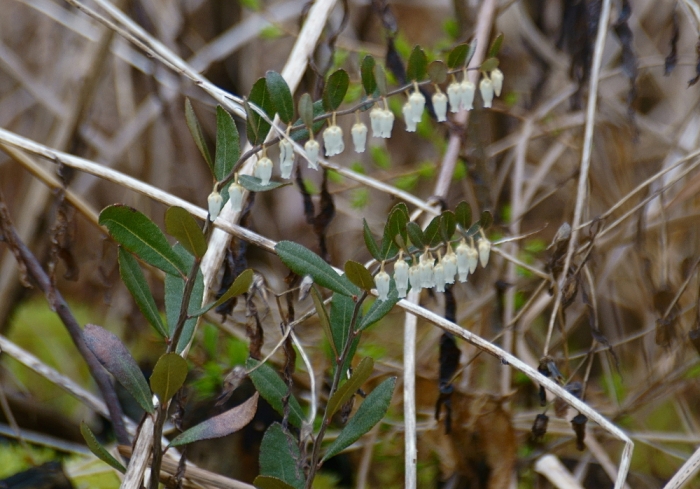Leatherleaf
(Chamaedaphne calyculata)
Leatherleaf (Chamaedaphne calyculata)
/
/

© psweet
CC BY-SA 4.0
Image By:
© psweet
Recorded By:
Copyright:
CC BY-SA 4.0
Copyright Notice:
Photo by: © psweet | License Type: CC BY-SA 4.0 | License URL: http://creativecommons.org/licenses/by-sa/4.0/ | Uploader: psweet | Publisher: iNaturalist |











Estimated Native Range
Summary
Chamaedaphne calyculata, commonly known as leatherleaf, is a deciduous dwarf shrub native to the acidic sphagnum bogs and wetlands of the cool temperate and subarctic regions of the Northern Hemisphere, including eastern North America, northern Europe, and northern Asia. It typically grows up to 5 feet tall and 4 feet wide, with a dense, rounded form. The leaves are thick, leathery, and evergreen, turning a red-brown color in winter. From April to June, leatherleaf produces small, white, bell-shaped flowers that are arranged in one-sided racemes, offering a subtle ornamental quality. The plant is known for its ability to form large clonal colonies, spreading via rhizomes.
Leatherleaf is valued for its hardiness and adaptability to wet, acidic soils, making it suitable for bog gardens and restoration projects. It is very shade-intolerant, requiring full sun to part shade for optimal growth. The plant is also known for acquiring nutrients from atmospheric sources, such as mist and rain, which allows it to thrive in nutrient-poor environments. In cultivation, it requires consistently moist to wet soil conditions. Leatherleaf is used by florists as a filler green in bouquets and has limited medicinal use among Native American tribes for treating various ailments. It is generally low-maintenance but can be susceptible to leaf spot diseases in humid conditions.CC BY-SA 4.0
Leatherleaf is valued for its hardiness and adaptability to wet, acidic soils, making it suitable for bog gardens and restoration projects. It is very shade-intolerant, requiring full sun to part shade for optimal growth. The plant is also known for acquiring nutrients from atmospheric sources, such as mist and rain, which allows it to thrive in nutrient-poor environments. In cultivation, it requires consistently moist to wet soil conditions. Leatherleaf is used by florists as a filler green in bouquets and has limited medicinal use among Native American tribes for treating various ailments. It is generally low-maintenance but can be susceptible to leaf spot diseases in humid conditions.CC BY-SA 4.0
Plant Description
- Plant Type: Shrub
- Height: 1-3 feet
- Width: 1-3 feet
- Growth Rate: Moderate
- Flower Color: White
- Flowering Season: Spring
- Leaf Retention: Evergreen
Growth Requirements
- Sun: Full Sun, Part Shade
- Water: Medium, High
- Drainage: Medium, Slow
Common Uses
Low Maintenance, Water Garden
Natural Habitat
Acidic sphagnum bogs and wetlands
Other Names
Common Names: Cassandra , Torfgränke , Leather Leaf
Scientific Names: Chamaedaphne calyculata , Andromeda angustifolia , Andromeda calyculata , Andromeda calyculata var. angustifolia , Andromeda calyculata var. anomala , Andromeda calyculata var. latifolia , Andromeda calyculata var. linearis , Andromeda calyculata var. nana , Andromeda calyculata var. ventricosa , Andromeda crispa
GBIF Accepted Name: